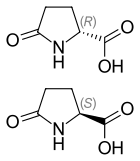
| |
| Names | |
|---|---|
| Preferred IUPAC name
5-Oxoproline | |
| Systematic IUPAC name
5-Oxopyrrolidine-2-carboxylic acid | |
Other names
| |
| Identifiers | |
3D model (JSmol)
|
|
| 3DMet | |
| Abbreviations | Glp |
| 82134 | |
| ChEBI |
|
| ChEMBL | |
| ChemSpider | |
| DrugBank | |
| ECHA InfoCard | 100.005.227 |
| EC Number |
|
| 1473408 | |
| KEGG | |
| MeSH | Pyrrolidonecarboxylic+acid |
PubChem CID
|
|
| RTECS number |
|
| UNII |
|
CompTox Dashboard (EPA)
|
|
| |
| |
| Properties | |
| C5H7NO3 | |
| Molar mass | 129.115 g·mol−1 |
| Melting point | 184 °C (363 °F; 457 K) |
| log P | -0.89 |
| Acidity (pKa) | -1.76, 3.48, 12.76 |
| Basicity (pKb) | 15.76, 10.52, 1.24 |
| Isoelectric point | 0.94 |
| Related compounds | |
Related compounds
|
proline 2-Pyrrolidone |
Except where otherwise noted, data are given for materials in their standard state (at 25 °C [77 °F], 100 kPa).
| |
Pyroglutamic acid (also known as PCA, 5-oxoproline, pidolic acid) is a ubiquitous but understudied natural amino acid derivative in which the free amino group of glutamic acid or glutamine cyclizes to form a lactam.[1] The names of pyroglutamic acid conjugate base, anion, salts, and esters are pyroglutamate, 5-oxoprolinate, or pidolate.

It is a metabolite in the glutathione cycle that is converted to glutamate by 5-oxoprolinase. Pyroglutamate is found in many proteins including bacteriorhodopsin. N-terminal glutamic acid and glutamine residues can spontaneously cyclize to become pyroglutamate, or enzymatically converted by glutaminyl cyclases.[2] This is one of several forms of blocked N-termini which present a problem for N-terminal sequencing using Edman chemistry, which requires a free primary amino group not present in pyroglutamic acid. The enzyme pyroglutamate aminopeptidase can restore a free N-terminus by cleaving off the pyroglutamate residue.[3]
Pyroglutamic acid exists as two distinct enantiomers:
- (2R) or D which happens to be (+) or d
- (2S) or L which happens to be (–) or l
- ^ Cite error: The named reference
throwingwas invoked but never defined (see the help page). - ^ Schilling, Stephan; Wasternack, Claus; Demuth, Hans-Ulrich (1 August 2008). "Glutaminyl cyclases from animals and plants: a case of functionally convergent protein evolution". Biological Chemistry. 389 (8): 983–91. doi:10.1515/BC.2008.111. PMID 18979624. S2CID 24074284.
- ^ Podell, David N.; Abraham, George N. (March 1978). "A technique for the removal of pyroglutamic acid from the amino terminus of proteins using calf liver pyroglutamate amino peptidase". Biochemical and Biophysical Research Communications. 81 (1): 176–185. doi:10.1016/0006-291X(78)91646-7. PMID 26343.